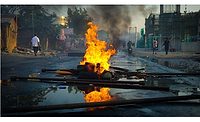The March multiple terror attacks in Brussels that resulted in more than 30 people killed and more than 250 injured raises again the specter of terrorism globally. While since 9/11 fewer than 50 people have been in killed in the United States due to jihadist-inspired terrorism, that paltry number fails to illustrate that the jihadi threat here is significant as hundreds – if not thousands – of persons would have succumbed to otherwise stymied plots. More specifically, there have been dozens of jihadi terror plots here during the past 14 years, especially since 2014 with those inspired by the Islamic State.
Jihadist activity on U.S. soil since September 11 includes successful attacks resulting in deaths, attacks causing injuries to victims, and attempted plots involving planned mayhem big and small. The participants of these incidents include individuals linked formally and/or ideologically across a variety of jihadist “homes,” including a multitude of U.S.-designated foreign terrorist organizations, among them al Qaeda, al Qaeda in the Arabian Peninsula (AQAP), Pakistani Taliban, and increasingly, of late, the Islamic State.
The perpetrators have acted as part of small cabals, linked by a variance of social networks – some family-affiliated or otherwise – and as lone wolves. The weaponry used most frequently that resulted in these killings was gunfire, followed by explosive devices. The targets of successful attacks included military and civilian settings.
From September 2001 through 2015, the number of victims killed during jihadist attacks in the United States was 44, arising from nine incidents (and their aftermaths):
- Hesham Mohamed Hadayet shot and killed two people and wounded four others at the El Al Israeli airline counter at Los Angeles International Airport in July 2002. An airline security officer shot and killed Hadayet. Hadayet was deemed to be a lone wolf inspired by anti-Israeli sentiments. He legally purchased the gun used in the attack.
- Naveed Haq killed one person and injured five during an attack with two semi-automatic pistols at the Seattle Jewish Federation office in July 2006. He was sentenced to life in prison. Haq, too, has been characterized as a lone wolf, triggered by anti-Israeli and anti-Semitic perspectives. He legally purchased the guns used in the incident.
- In June 2009, Carlos Bledsoe carried out a drive-by shooting (with a rifle) at a military recruiting station in Little Rock, Arkansas. The incident resulted in the death of one U.S. soldier and injury of another. He was sentenced to life in prison. Bledsoe claimed affiliation with AQAP. He is alleged to have met Anwar al-Awlaki, the group’s former senior operative.
- Dr. Nidal Hasan killed 13 and injured another 39 during a shooting at Fort Hood, Texas, in November 2009. Hasan was shot and injured by police during their response to the incident. He was sentenced to death for the murders. Hasan legally purchased the handgun used in the attack. Prior to the incident, Hasan communicated online with al-Awlaki.
- In April 2013, Tamerlan and Dzhokhar Tsarnaev detonated two improvised explosive devices at the Boston Marathon, killing three and injuring more than 260. In the days following the attack, Tamerlan shot and killed one MIT police officer (the gun used was loaned to Dzhokhar), while one Boston police officer was killed after the brothers released pressure cooker bombs from their car during a police chase. Tamerlan was killed when his brother ran him over while they were evading police. Dzhokhar was found guilty of perpetrating the attacks and sentenced to death. This cabal was inspired by various jihadist ideals.
- Between April and June 2014, Ali Muhammad Brown shot and killed three people in Seattle, Washington, during different incidents, and another person later in New Jersey. Brown claimed to have undertaken the attacks in retaliation for U.S. foreign policy in the Middle East. Brown’s wife legally purchased the handgun that was used in the murders.
- In September 2014, Alton Nolen beheaded a female co-worker and attempted to behead another woman in Oklahoma City, Oklahoma, before he was shot and taken into custody. Nolen’s Facebook page had photos and commentary on jihadi beheadings as well as photos of jihadi fighters. In 2016, Nolen is on trial for these crimes.
- In July 2015, Muhammad Youssef Abdulazeez attacked two military locations in Chattanooga, Tennessee, killing five persons, and injuring two others. Abdulazeez initially attacked a military recruiting center, and later drove to a U.S. Navy Reserve center, where the fatalities took place. Police killed Abduelazeez while responding to the incident. He used several weapons in the attack, including a semi-automatic rifle, shotgun and handgun, a number of which were acquired legally. The FBI reported that Abdulazeez was inspired by a foreign terrorist organization.
- In December 2015, Syed Rizwan Farook and his wife Tashfeen Malik attacked a holiday party in San Bernardino, California, organized by Farook’s employer, killing 14 and wounding 21 others, using semiautomatic weapons (purchased legally by Farook’s friend, Enrique Marquez, several years earlier). The couple had been radicalized for several years, including prior to meeting. Malik pledged allegiance to Islamic State leader al-Baghdadi during their attack.
Besides attacks resulting in deaths and injuries, failed plots encompassed some plans to kill scores. Core al Qaeda-directed ineffectual plots included infamous shoe bomber Richard Reid in 2001, and three planned simultaneous suicide bombers in NYC in 2009, led by Najibullah Zazi.
Also, in 2009, AQAP-linked Umar Farouk Abdulmutallab unsuccessfully detonated an explosive device on a flight from Amsterdam, the Netherlands, to Detroit, Michigan, with nearly 300 people on board. The following year, Faisal Shazad, a Pakistani Taliban-connected perpetrator, detonated a poorly devised vehicle-borne explosive device in New York’s Times Square.
Unaffiliated jihadist-inspired terrorists likewise sought to kill during many planned or actual attacks. In March 2006, Mohamed Taheri Azar, an Iranian-born U.S. citizen, tried to run over University of North Carolina-Chapel Hill students with a rented SUV at an outdoor, on-campus hangout. In August 2008, he pleaded guilty to nine counts of attempted murder and sentenced to over two decades in prison.
Although many subsequent failed plots included operatives who interacted with informants and/or undercover agents during sting operations, the lethal intentions of the operatives should not be characterized as otherwise. For example, in 2009 two lone wolf plotters separately attempted to detonate what they believed were vehicle-borne explosives. Hosam Smadi and Michael Finton targeted a Dallas, Texas, skyscraper, and a federal building in Springfield, Illinois, respectively.
More recently, other jihadists sought to kill numerous persons in, ultimately, failed terror plans. In September 2012 Ahmed Daoud attempted to remotely detonate a vehicle-borne explosives device outside a Chicago, Illinois, bar. According to taped conversations during a sting operation. Daoud intended to kill many, “If it’s only like five, 10 people, I’m not gonna feel that good. I wanted something that’s ... massive.” In 2016, Daoud is on trial for that crime.
In March 2015, Jonas Edmonds, one of two Illinois-based cousins inspired by the Islamic State, was arrested in relation to a plot to kill some 150 people in an intended attack at the National Guard base in Joliet. His cousin, Hasan, was arrested prior to boarding an overseas flight with an intention to travel and join the self-declared caliphate. The pair ultimately pleaded guilty to conspiracy to provide material support to the group (Hasan also for attempting to provide such support) as the sting operation served its objective.
Other significant, failed Islamic State-inspired plots during 2015 were comprised of a: planned attack at the U.S. Capitol using semiautomatic weapons and pipe bombs (Christopher Lee Cornell), suicide bombing to be conducted at the Ft. Riley, Kansas (John T. Booker, Jr.), and improvised explosive device to be left on a crowded beach in Florida (Harlem Saurez).
Jihadist-linked planned carnage continues here as illustrated by a 2016 case. Khalil Abu-Rayya told an undercover agent that he intended to undertake an Islamic State-inspired attack at a 6,000-member church in Detroit. Later, Abu-Rayyan was arrested for another crime.
To reiterate, the attacks in Brussels merely illustrate that the intentions and capabilities of jihadist terror groups – and those inspired by them in cabals or as lone wolves – are real and worthy of taking seriously in the homeland and abroad.





